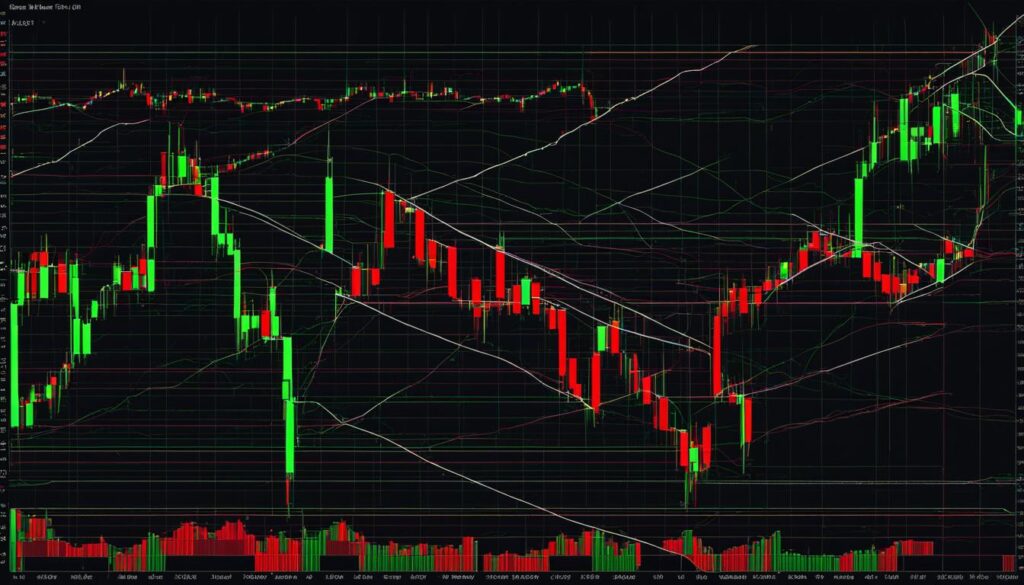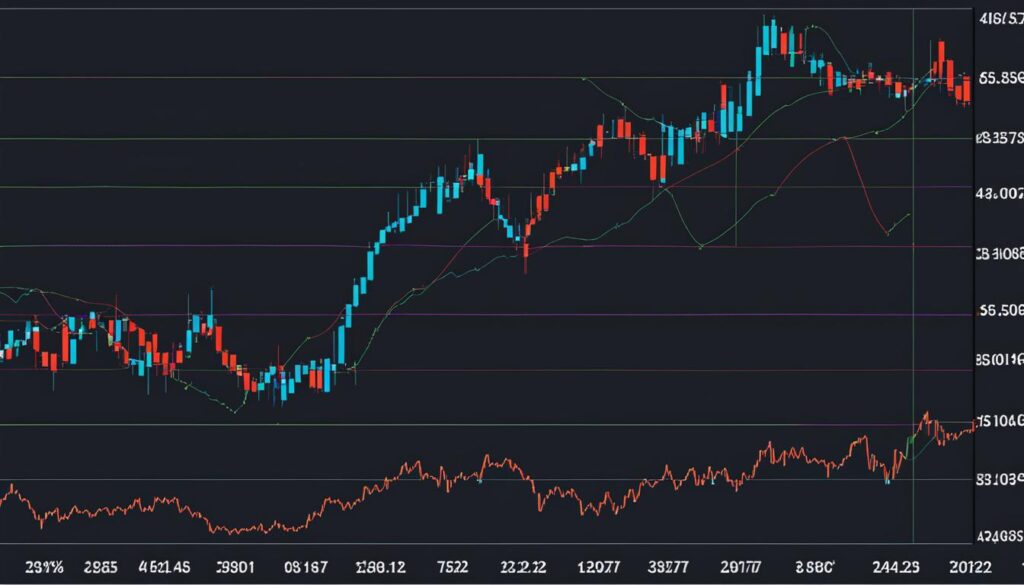In volatile markets, understanding and utilizing advanced options trading strategies can be key to success. These strategies involve techniques such as delta neutral trading, which allows traders to profit from declines in implied volatility. By constructing a neutral position delta and shorting vega, traders can take advantage of volatility swings without relying on the movement of the underlying asset. This approach is particularly effective when implied volatility levels are high and can provide a statistical edge when trading.
Key Takeaways:
- Diversifying trading strategies is crucial in volatile markets.
- Delta neutral trading allows traders to profit from changing volatility levels.
- Implementing delta neutral strategies requires understanding option Greeks.
- Example: Reverse diagonal calendar spread on the S&P 500.
- Advanced techniques like delta hedging enhance delta neutral trading.
The Delta Neutral Approach to Trading Options
The delta neutral approach to trading options is a strategic method that aims to establish a portfolio with a net delta value of zero. This means that changes in the price of the underlying asset have minimal impact on the overall value of the portfolio. By utilizing a combination of options and their underlying securities, traders can balance positive and negative delta positions to minimize directional risk and take advantage of increased volatility in the options market.
“The delta neutral approach allows traders to navigate volatile markets with a statistical edge, regardless of the direction of the underlying asset.”
The key concept behind the delta neutral approach is to create a portfolio that is immune to changes in the price of the underlying asset. This is achieved by carefully selecting options contracts with different delta values and combining them with their corresponding underlying securities. By doing so, traders can offset the positive and negative deltas and achieve a net delta of zero.
The delta of an option measures the sensitivity of its price to changes in the price of the underlying asset. By balancing positive and negative delta positions, traders can ensure that changes in the price of the underlying asset have minimal impact on the overall portfolio value.
One of the primary advantages of the delta neutral approach is its ability to allow traders to profit from increased volatility in the options market. As volatility increases, options prices tend to rise, providing opportunities for traders to capture gains. By establishing a delta neutral position, traders can capitalize on these volatility swings without relying on the movement of the underlying asset.
The delta neutral approach can be particularly effective in volatile markets, where price movements can be unpredictable. It enables traders to navigate market fluctuations with greater confidence and reduce the risk associated with directional trades. This approach provides a statistical edge by taking advantage of volatility swings, regardless of whether the market moves up or down.
Benefits of the Delta Neutral Approach:
- Minimize directional risk
- Profit from increased volatility
- Take advantage of market fluctuations
- Reduce reliance on the movement of the underlying asset
Example Delta Neutral Position:
Consider the following delta neutral options trading example:
| Options Contracts | Underlying Securities | Delta |
|---|---|---|
| Long Call | 100 shares of XYZ stock | +0.50 |
| Short Put | 100 shares of XYZ stock | -0.50 |
| Long Stock | No options | +1.00 |
In this example, the long call and short put options contracts have opposite delta values but are combined with the underlying securities to achieve a net delta value of zero. The long stock position, representing 100 shares of XYZ stock, has a delta of +1.00. By balancing the positive and negative delta positions, the overall delta value of the portfolio remains neutral.
Implementing Delta Neutral Strategies
To successfully implement delta neutral strategies in options trading, it is crucial for traders to have a comprehensive understanding of the various option Greeks: delta, gamma, theta, and vega. These Greek parameters play a significant role in determining the behavior of options prices in response to changes in the underlying asset’s price, time decay, and volatility.
Delta represents the sensitivity of an option’s price to changes in the underlying asset’s price. A delta of 0.5 indicates that for every $1 change in the underlying asset’s price, the option price will change by $0.50.
Gamma measures the rate at which delta changes in response to fluctuations in the underlying asset’s price. Traders need to pay attention to gamma as it affects the stability and risk exposure of delta-neutral positions.
Theta captures the time decay of an option’s value, quantifying the decline in price due to the passage of time. It is essential for traders to monitor theta to effectively manage their positions and avoid excessive losses resulting from time decay.
Vega gauges an option’s sensitivity to changes in volatility. High vega implies that the option price is more susceptible to fluctuations in implied volatility, while low vega indicates less sensitivity.
By comprehending and effectively managing these option Greeks, traders can adjust their positions strategically to maintain a delta neutral portfolio. This approach allows traders to take advantage of volatility swings while minimizing exposure to directional risk. Delta neutral strategies provide traders with an opportunity to capitalize on changing market conditions with a statistical edge.
To summarize, implementing delta neutral strategies requires a thorough understanding of option Greeks, specifically delta, gamma, theta, and vega. By managing these factors effectively, traders can construct and maintain a delta neutral portfolio, enabling them to profit from volatility swings in the options market.
Delta Neutral Options Trading Example
Let’s dive into a concrete example of delta neutral options trading to gain a better understanding of how this strategy works. In this example, we will focus on using a reverse diagonal calendar spread on the S&P 500.
A reverse diagonal calendar spread is a delta neutral strategy that involves selling at-the-money calls for the distant-month options and buying higher strike calls for the nearer-month options. By doing so, the trader aims to benefit from the time decay of the nearer-month options while maintaining a neutral position delta.
To achieve delta neutrality, the trader adjusts the position by buying futures contracts. This ensures that the overall delta value of the portfolio remains close to zero, minimizing the impact of changes in the price of the underlying asset.
Let’s take a look at a profit/loss chart that illustrates the potential gains from a decline in implied volatility:

In this chart, we can see that the strategy provides a near-perfect hedge against downside risk, while also offering profit potential in a wide range of prices for the underlying asset. This highlights the advantage of delta neutral options trading in volatile markets.
By implementing delta neutral strategies like the reverse diagonal calendar spread and adjusting the position to maintain delta neutrality, traders can navigate volatile markets with confidence.
Summary:
– Reverse diagonal calendar spread: Selling at-the-money calls for the distant-month options and buying higher strike calls for the nearer-month options.
– Adjusting position with futures contracts to achieve delta neutrality.
– Profit/loss chart showcasing potential gains from a decline in implied volatility.
Advanced Techniques for Delta Neutral Trading
In addition to the basic delta neutral strategies discussed in the previous section, there are advanced techniques that can further enhance delta neutral trading. These techniques allow traders to fine-tune their positions and navigate volatile markets with greater precision and control.
Delta Hedging
One advanced technique used in delta neutral trading is delta hedging. This strategy involves adjusting positions to offset changes in delta values as the underlying asset’s price moves. By doing so, traders can maintain a delta-neutral portfolio and minimize the impact of price fluctuations on their overall position. Delta hedging helps ensure that the portfolio’s value remains relatively stable regardless of market conditions.
Monitoring and Adjusting for Changes in Implied Volatility
Another important aspect of advanced delta neutral trading is monitoring and adjusting for changes in implied volatility. Implied volatility is a key factor that affects options prices, and its fluctuations can impact delta values. By closely monitoring changes in implied volatility and making necessary adjustments to their positions, traders can maintain a delta-neutral portfolio and take advantage of volatility swings to maximize their profits.
Synthetic Options and Strike Price Hedging
Traders can also utilize synthetic options and strike price hedging as part of their risk management and delta neutral strategies. Synthetic options involve creating positions that mimic the behavior and characteristics of a specific option through a combination of other options and underlying assets. This technique allows traders to replicate the desired risk profile while maintaining a delta-neutral position.
Strike price hedging is another advanced technique that can be employed in delta neutral trading. By adjusting the strike price of options contracts in their portfolio, traders can manage their exposure to directional risk and maintain a delta-neutral position. This strategy helps protect against adverse movements in the underlying asset’s price while still allowing for potential profit opportunities.

By incorporating these advanced techniques into their delta neutral trading strategies, traders can gain a competitive edge in volatile markets. These techniques provide greater flexibility and control over portfolio management, allowing traders to navigate changing market conditions with confidence.
| Advanced Techniques for Delta Neutral Trading | Benefits |
|---|---|
| Delta Hedging | Minimizes the impact of price fluctuations on the portfolio |
| Monitoring and Adjusting for Changes in Implied Volatility | Capitalizes on volatility swings and maximizes profits |
| Synthetic Options and Strike Price Hedging | Replicates desired risk profile and maintains a delta-neutral position |
Conclusion
In conclusion, advanced options trading strategies, such as delta neutral trading, provide traders with a powerful tool to navigate and profit from volatile markets. By implementing delta neutral strategies, traders can effectively manage risk and capitalize on volatility swings without relying solely on the direction of the underlying asset. Techniques like delta hedging and strike price hedging further enhance risk management and allow traders to navigate unpredictable market conditions with confidence.
It is important to note that options trading involves inherent risks, and proper risk management is crucial for success. Traders should have a thorough understanding of options pricing, option Greeks (such as delta, gamma, theta, and vega), and risk management techniques. This knowledge empowers traders to make well-informed decisions and adapt their positions as market conditions change.
By employing advanced options trading strategies, traders can seize opportunities in volatile markets and potentially achieve consistent profitability. However, it is essential to approach options trading with a disciplined mindset, carefully assess potential risks, and continually educate oneself on new strategies and market trends. With dedication and a deep understanding of advanced options trading strategies, traders can navigate the complex world of options trading and maximize their trading potential.
FAQ
What are advanced options trading strategies?
Advanced options trading strategies are techniques that traders use to maximize their profits and minimize their risks in volatile markets. These strategies involve advanced concepts like delta neutral trading and employ techniques such as delta hedging and strike price hedging.
What is the delta neutral approach to trading options?
The delta neutral approach to trading options involves constructing a portfolio with a net delta value of zero. This means that changes in the price of the underlying asset have minimal impact on the overall value of the portfolio. It helps traders minimize directional risk and take advantage of increased volatility in the options market.
How do you implement delta neutral strategies?
To implement delta neutral strategies, traders need to understand and consider various option Greeks such as delta, gamma, theta, and vega. By balancing positive and negative delta positions using a combination of options and their underlying securities, traders can maintain a delta neutral portfolio and capitalize on volatility swings.
Can you provide an example of delta neutral options trading?
Sure! One example of delta neutral options trading is a reverse diagonal calendar spread on the S&P 500. Traders sell at-the-money calls for distant-month options and buy higher strike calls for nearer-month options. The position is then adjusted to achieve delta neutrality by buying futures contracts. This strategy provides a near-perfect hedge against downside risk and profit potential in a wide range of prices for the underlying asset.
What are some advanced techniques for delta neutral trading?
Some advanced techniques for delta neutral trading include delta hedging, where traders adjust their positions to offset changes in delta values as the underlying asset’s price moves. Traders can also monitor and adjust for changes in implied volatility and employ synthetic options and strike price hedging as part of their risk management and delta neutral strategies.
What is the conclusion about advanced options trading strategies?
In conclusion, advanced options trading strategies, such as delta neutral trading, offer traders the opportunity to profit from volatile markets. By implementing these strategies and using advanced techniques like delta hedging and strike price hedging, traders can manage risk effectively and capitalize on volatility swings. However, it is crucial to remember that options trading involves risks, and proper risk management is essential.




Thanks for sharing. I read many of your blog posts, cool, your blog is very good.